|
Character Matters
By Ann Jarmusch
What exactly gives San Diego its character and sets it apart from other cities? Is it prominent icons, such as California Tower in Balboa Park and Victorian mansions with towering turrets throughout the county? Are we experiencing authentic San Diego on Old Town's busy, breezy plaza and aboard the floating Star of India? Inside the massive stone walls of Amy Strong Castle and beneath the fringe of the historic surf hut at Windansea Beach?
We asked preservationists throughout San Diego County to define and describe the essence of this place and their answers are as rich and diverse as the county itself. It's the "intimate character, the small town feel," said architect Ione R. Stiegler. It's our Native American, Spanish, Mexican and Anglo heritage, others said. Then there's the climate, of course, said Phyllis Paul, co-editor of Rancho Santa Fe: A California Village, who also declared the county and its attractions "gorgeous, interesting and sparkling."
San Diego is about our highly romanticized images of our city's past. Let's keep it that way. - M. Wayne Donaldson
The heavenly climate that has attracted generations of health- and recreation-minded vacationers and newcomers led Lynne Newell Christenson, County of San Diego Historian, to the conclusion that San Diego's true character literally crisscrosses the land.
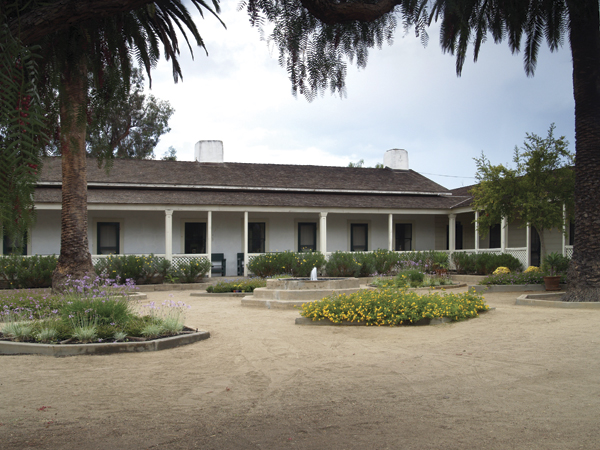
Follow a trail in the dusty footsteps of your predecessors and you'll come to Santa María de los Peñasquitos Adobe (circa 1823), now a house museum, in Los Peñasquitos Canyon Preserve.
|
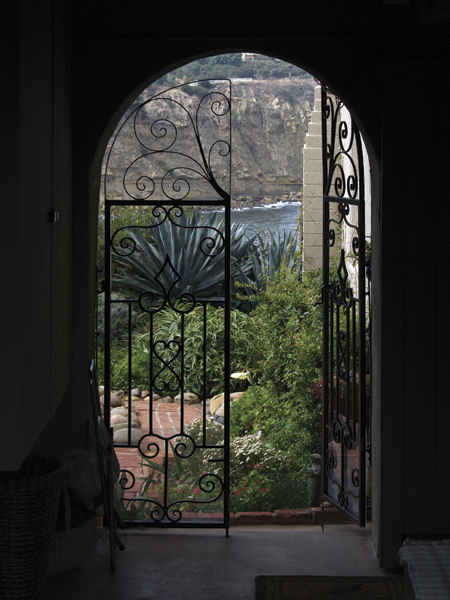
The Wheeler Bailey House (1907), designed by Irving Gill and Frank Mead for what was then a remote bluff overlooking La Jolla Cove, married shelter and nature in an inviting Mediterranean climate. A brick path through a rustic garden leads to the majestic sea.
|
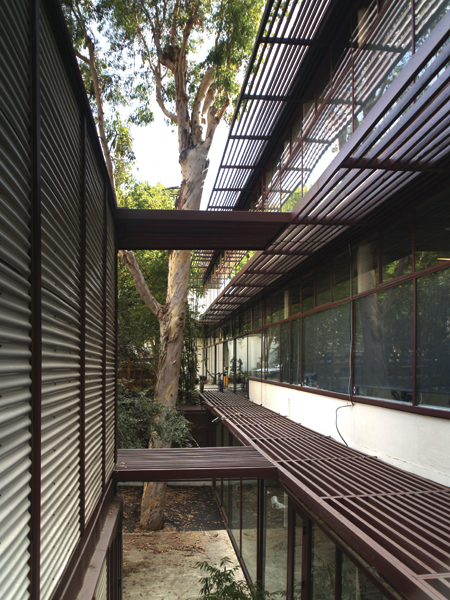
Architect Lloyd Ruocco made the most of San Diego's indoor-outdoor living potential and refreshing views into a steep canyon when he sited the Design Center (1949), an icon of San Diego modernism, in Hillcrest. Once filled with architecture and design studios, including two belonging to Ruocco and his wife Ilse, an interior designer, the restored center now houses a mix of tenants.
|
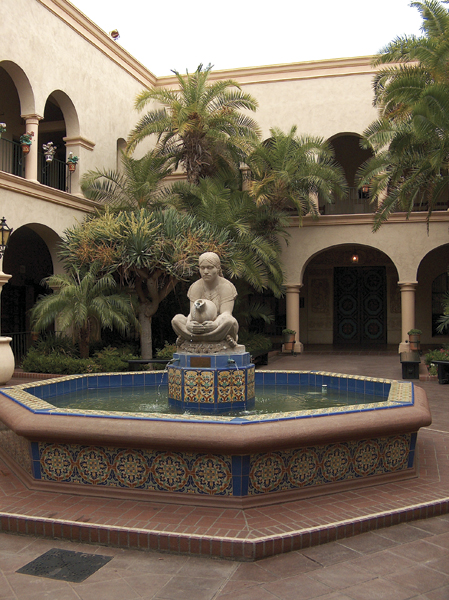
The House of Hospitality in Balboa Park, reconstructed in 1997 to match Richard Requa's design and décor for the 1935-36 California Pacific Exposition, represents a festive blend of San Diego's roots in Spanish, Mexican and Native American cultures. Donal Hord's serene fountain sculpture, "Woman of Tehuantepec," rests on a base of Spanish-style tile.
|
"San Diego does as much if not more than other communities to develop multiuse recreational trails, especially around riverbeds. Some are historic trails or stage routes, so when we set foot on these paths we're following in the footsteps of Europeans, the prospectors who came on the southern route during the Gold Rush, and Native Americans.
"I like to get out and hike in areas where you're no longer aware you're in or near a city. I think about how people used these trails 100 years ago and look for evidence of how they were connected to the land, such as citrus trees or a house foundation, because history is tied to biology and the environment," Christenson said.
M. Wayne Donaldson, a former SOHO board member who has temporarily left San Diego to work throughout California while serving as the State Historic Preservation Officer, offered a perspective he said has come into sharper focus for him since his departure. "As San Diegans, we continue to see ourselves with double vision as we plan for our future. Are we The City Beautiful, tied to our romantic scenic beauty and Mediterranean resort living, or destined to be another Century of Progress, Anywhere USA? There was a time I felt San Diego could become an incredibly vibrant community, connecting our historic Spanish Colonial roots of Balboa Park, by using the revitalization corridor of the Gaslamp Quarter's early formative commercial years, to San Diego Bay, with its recreational, military and industrial operations. Now, downtown has been transformed into a vibrant center with lots of things happening but disconnected to our history, romance and the Southern California-style of living. Loft living is good, but Gaslamp does not exist south of Island Street. Even the Santa Fe Depot, so reflective of San Diego's new romantic image of 1915, is lost in a canyon of new towers.
"Hope is still alive in our old neighborhoods - Kensington, Mission Hills, La Jolla, Loma Portal, North Park," Donaldson added. "They still feel good, still contain a great romantic sense of place. San Diego is about our highly romanticized images of our city's historic past. Let's keep it that way."
Barry Hager, president of Mission Hills Heritage and former SOHO Vice President, also pointed to the city's historic neighborhoods. He feels a lively connection to San Diego's true identity when he walks along what could be called Bungalow Heaven on 28th Street in North Park or on West Lewis Street in Mission Hills, where attractive shops, a small market and necessities, such as a plumbing supply store, have long been nestled into a residential area. In architecture and layout, Hager noted, "these older neighborhoods that grew up around downtown San Diego convey a sense of our past and the early growth patterns that made San Diego a city."
"Geography and topography greatly influenced the development of La Jolla, which blossomed from a refreshing if remote destination for seaside outings into a thriving coastal town within the city of San Diego," said Carol Olten, La Jolla Historical Society historian and co-author of a new book on La Jolla. Sea cliffs, sea caves, La Jolla Cove and ragged coastal edges conspired with steep terrain against gridded street plans, yet the place seduced early land owners into trying. In the 1880s, they began building single-wall redwood cottages overlooking the cove, simple structures that are today either treasured (Brockton Villa and Wisteria Cottage) or notoriously neglected (Red Rest and Red Roost).
David Marshall, architect and former SOHO president, looked through history's lens to question the premise of asking the "real" San Diego to please stand up. "Authentic to us in 2008 is likely very different from what some of our Native American, Mexican and Anglo-Saxon predecessors might say. San Diego would look very different without those influences."
"If I were to define a 'San Diego Style,' today," Marshall continued, "I'd look no further than Bertram Goodhue's fanciful reinterpretation of Spanish Colonial Revival architecture in Balboa Park and Irving Gill's stripped-down modernist spin on Mission Revival architecture. Gill's style is more purely San Diegan, since it originated here, but both of these styles are rooted in San Diego's Hispanic heritage and are further justified by our sunshine and temperate climate. Prior to 1915, almost everything built in San Diego was borrowed from another city or country, regardless of its relevance to our city."
Borrowing doesn't bother James M. Schibanoff. Although he can recite San Diego's architectural history with the best of them, he admits to another perspective he concedes is "a little anomalous."
"I read a lot about regional authentic character and how California reinvents itself, but that doesn't really resonate with me," said Schibanoff, a preservation leader in Del Mar and former SOHO board member. "I love San Diego (I've lived here since 1970), but I love many other American cities, too, and enjoy traveling. In San Diego, I like to see representations of architecture associated with other cities. South Beach in Miami is filled with Art Deco, but there's very little of it in San Diego. So when I see an Art Deco building here, I like the association with South Beach."
Marshall said Art Deco, Moderne, International, Post-Modern and other 20th century architectural styles "have their place in San Diego, but I wouldn't consider any of them 'authentic.' 'Authentic' contenders would be the works of Richard Requa, William Templeton Johnson, the ranch house (which has a regional connection) and the humanistic/modernist buildings of Lloyd Ruocco, Sim Bruce Richards, and James Hubbell."
Victor A. Walsh, historian for California State Parks' San Diego Coast District, pinpointed the years between the two World Wars - and the 1915 and 1935 expositions in Balboa Park - as "San Diego's cultural renaissance." Visionary leaders such as George Marston and Daniel Cleveland implemented enduring and defining assets, such as park and playground development and beautification and new cultural institutions. "The overarching theme here was to create an integrated community, a city with a unique character that exemplified its appeal as a place to live as well as to work."The Spanish Colonial Revival and Mediterranean architectural styles of the Balboa Park expositions played a critical role in shaping the city and its renaissance," Walsh added. "Drive down the tree-lined streets of Kensington Heights, developed in the 1920s according to guidelines by architect Richard Requa [who would go on to be the 1935 exposition's chief architect]. You'll see that the houses are small, unimposing, like cottages in a small town set back from the street. They have a typical Spanish character, the tile roofs and white stucco facades, but each one has a distinctive feature - a rounded chimney or arched doorway - that makes it stand out. Each is distinctive, yet integrated into the larger whole. What springs out when I drive or walk down these streets is that the design lends itself to interaction, to an ethic of neighborliness, which is sadly missing in much of American society today."
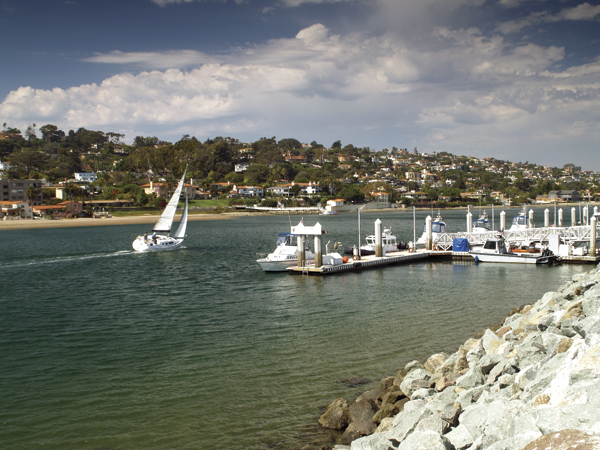
The hilly peninsula of Point Loma, bathed by both the ocean and San Diego Bay, has been an alluring place to call home since Kumeyaay times. Life on the water is one of San Diego most prized characteristics as well as a commercial, recreational and tourist boon.
For Keith York, founder and resident blogger of the web site www.modernsandiego.com, "Timing is everything." What makes San Diego different from other cities is "a confluence of unique variables" that drew people here after World War II. "Those who came at that time arrived with a different reason, rationale and disposition than did people who moved to most other American cities," different, even, from "Los Angeles's seemingly parallel track," York wrote.
"San Diego's military prominence and the growth of associated industries drew commissioned officers and business leaders, enlisted soldiers, sailors and factory workers and their families," York continued. This population boom resulted in a market for custom homes (superbly designed for this place by native San Diegan Lloyd Ruocco, for example) and a great need for middle-class housing (fulfilled by tract home builders Palmer & Krisel and others). "And that need, coupled with an 'anything goes out west' cultural foundation allowed for new ideas, new technology, new materials - a veritable blank slate for many of the region's new residents," according to York.
Blank slate for some, cake of many layers for others. There is, of course, no "correct" way to define the essence of San Diego, but the more we discuss its characteristics, the better prepared we'll be to preserve the places that matter most and ring truest.
If you'd like to join this conversation about the essence of historic San Diego, please mail your comments to "Character Counts," SOHO, 2476 San Diego Avenue, San Diego CA 92110 or email them (with "Character Counts" as the subject) to SOHOSanDiego@aol.com.
Ann Jarmusch, formerly The San Diego Union-Tribune architecture critic, has contributed to American Craft, Architectural Record, ARTnews and Town & Country, among other magazines.
All photos by Sandé Lollis
The preservationists we asked to distill the essence of San Diego also had ideas about which key resources are at risk and how best to protect them. Here are some of their priorities:
- The creation of more historic or thematic districts to retain neighborhood history, character and continuity, such as the two districts recently established in Mission Hills with the help of Barry Hager and Mission Hills Heritage. "Los Angeles has dozens of districts and Pasadena has used historic districts with great success to preserve its older neighborhoods," Hager wrote. "We need to be more aggressive in implementing historic districts in San Diego before it is too late."
- Historic interiors. Intact period interiors are being "ripped out every day, even when the facades survive," wrote David Marshall, citing the Keating Building and Maryland (now Ivy) Hotel in downtown San Diego. He called for increased protections, monitoring and public education.
- Demolition ordinances with delay clauses and other protections for historic buildings. Phyllis Paul, who mourns Lilian Rice-designed buildings that were destroyed overnight in Rancho Santa Fe, has been advocating a demolition ordinance in that community. "The county doesn't have one either; that would help us," Paul said. (She'd also like to form an official Rice thematic district.)
- "Less affluent neighborhoods and the commercial corridors that run through them" shouldn't be overlooked," wrote Victor A. Walsh. We have already lost character-defining theaters, schools, hotels and commercial structures.
- Modernism is the newest preservation baby. James M. Schibanoff fears for the single-story, modern ranch house, designed by the thousands according to Cliff May's plans for indoor-outdoor living. Especially endangered, he said, are custom built ranch homes that conform so naturally to Del Mar's hillsides that they're hidden from view, but not from the clutches of McMansion fans. Long overlooked post-World War II urban and suburban housing tracts such as Clairemont, University City and sections of Point Loma are coming into focus for their social history, livability and what they can teach us about "a need for strong design elements on a mass scale," wrote Keith York.
|
|
MORE FROM THIS ISSUE
From the Editor
2008 Most Endangered List of Historic Resources
Character Matters
Smart Growth - or is it?
The Impact of Historic Districts
Washington Didn't Sleep Here
How to Research Your House
Preserving Community Character
Behind the Tuscany Craze
2008 People In Preservation Award Winners
Preservation Community
Reflections
Annual Financial Report
Book Review - Working Windows
Sherlock Homes
Speakers Bureau Forming
Lost San Diego
Strength in Numbers
Advertisements
DOWNLOAD full magazine as pdf (16mb)
|








